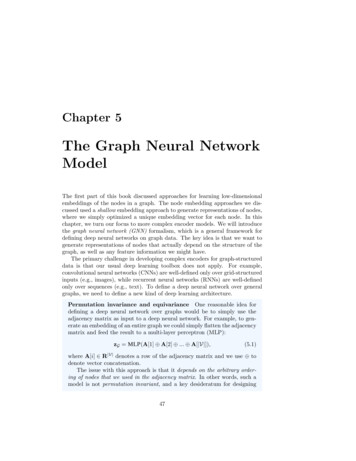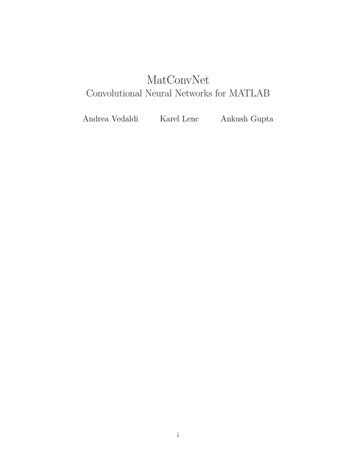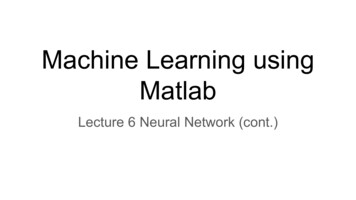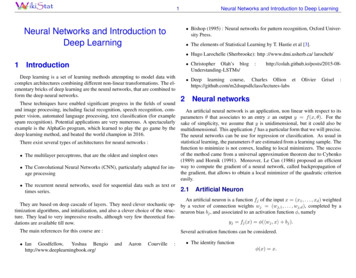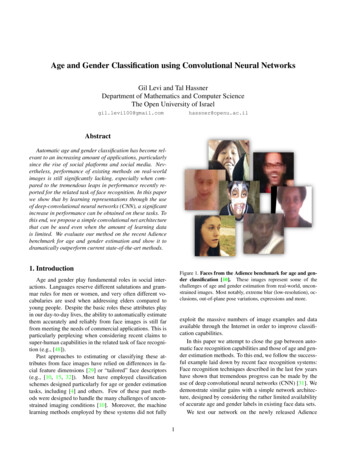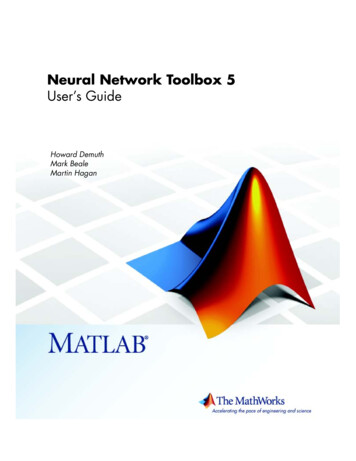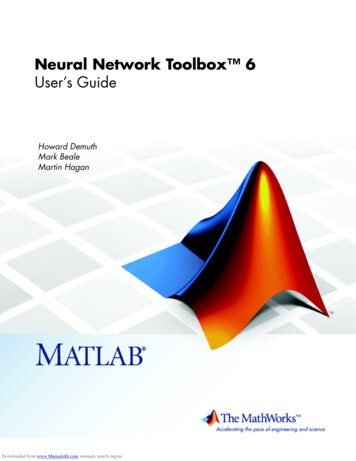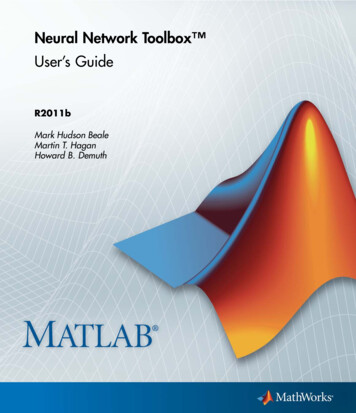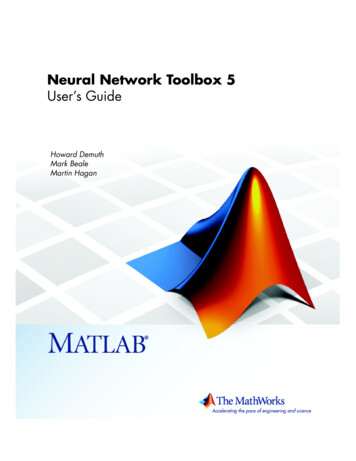
Transcription
Convolutional Neural Networks on Surfaces via Seamless Toric CoversHAGGAI MARON, Weizmann Institute of ScienceMEIRAV GALUN, NOAM AIGERMAN, MIRI TROPE, NADAV DYM, Weizmann Institute of ScienceERSIN YUMER, VLADIMIR G. KIM, Adobe ResearchYARON LIPMAN, Weizmann Institute of SciencebbbabbabbababaaabababaaaaaabbThe recent success of convolutional neural networks (CNNs) for imageprocessing tasks is inspiring research e orts attempting to achieve similarsuccess for geometric tasks. One of the main challenges in applying CNNsto surfaces is de ning a natural convolution operator on surfaces.In this paper we present a method for applying deep learning to spheretype shapes using a global seamless parameterization to a planar at-torus,for which the convolution operator is well de ned. As a result, the standarddeep learning framework can be readily applied for learning semantic, highlevel properties of the shape. An indication of our success in bridging thegap between images and surfaces is the fact that our algorithm succeedsin learning semantic information from an input of raw low-dimensionalfeature vectors.We demonstrate the usefulness of our approach by presenting two applications: human body segmentation, and automatic landmark detectionon anatomical surfaces. We show that our algorithm compares favorablywith competing geometric deep-learning algorithms for segmentation tasks,and is able to produce meaningful correspondences on anatomical surfaceswhere hand-crafted features are bound to fail.babCCS Concepts: Computing methodologies Neural networks; Shapeanalysis;Additional Key Words and Phrases: Geometric deep learning, Convolutionalneural network, Shape analysis, shape segmentationACM Reference format:Haggai Maron, Meirav Galun, Noam Aigerman, Miri Trope, Nadav Dym,Ersin Yumer, Vladimir G. Kim, and Yaron Lipman. 2017. Convolutional NeuralNetworks on Surfaces via Seamless Toric Covers. ACM Trans. Graph. 36, 4,Article 71 (July 2017), 10 pages.DOI: TIONA recent research e ort in the geometry processing and vision communities is to translate the incredible success of deep convolutionalneural networks (CNN) to geometric settings. One particularly interesting scenario is applying CNNs for supervised learning of functions or labels over curved two dimensional sphere-like surfaces.This is a common problem in analyzing human bodies, anatomical,and medical data.Applying CNNs to extrinsic surface representation such as volumetric grids [Qi et al. 2016b] or depth map projections on extrinsic2D cameras [Wei et al. 2016] requires working with 3D grids, ordealing with many camera and lighting parameters, and is very sensitive to deformations (e.g., human pose changes). While it might bePermission to make digital or hard copies of all or part of this work for personal orclassroom use is granted without fee provided that copies are not made or distributedfor pro t or commercial advantage and that copies bear this notice and the full citationon the rst page. Copyrights for components of this work owned by others than ACMmust be honored. Abstracting with credit is permitted. To copy otherwise, or republish,to post on servers or to redistribute to lists, requires prior speci c permission and/or afee. Request permissions from permissions@acm.org. 2017 ACM. 0730-0301/2017/7-ART71 15.00DOI: http://dx.doi.org/10.1145/3072959.3073616Fig. 1. Defining convolutional neural networks on sphere-like surfaces: weconstruct a torus (top-right) from four exact copies of the surface (top-le )and map it to the flat-torus (bo om-right) to define a local, translationinvariant convolution (bo om-le ). This construction is unique up to achoice of three points on the surface (colored disks).possible to learn a representation that is invariant to these deformations, this requires substantial amount of training data. In contrast,the goal of our paper is to provide an intrinsic representation thatwould enable applying CNNs directly to the surfaces.One of the main challenges in applying CNN to curved surfacesis that there is no clear generalization of the convolution operator. In particular, two properties of the convolution operator thatare considered pivotal in the success of the CNN architectures arelocality and translation invariance. It is possible to parameterize asurface locally on a geodesic patch around a point [Masci et al. 2015],however, this representation lacks global context. Sinha et al. [2016]proposed geometry images to globally parameterize sphere-likesurface into an image, however, although continuous, their representation is not seamless (the parameterization is dependent on thecuts made for its computation), their space of parameterizations,namely area-preserving maps has a very high number of degrees offreedom (i.e., it requires an in nite number of point constraints touniquely de ne a mapping) and therefore can represent the sameshape in many di erent arbitrary ways in the image (see Figure 2for an example). Lastly, the convolution on the geometry image isnot translation invariant.ACM Transactions on Graphics, Vol. 36, No. 4, Article 71. Publication date: July 2017.
71:2 H. Maron et. al.De ning a local translation invariant convolution operator onsurfaces is not trivial. The rst hurdle is topological: the only surfacetype for which a translation invariant convolution is well de ned isthe torus (this will be explained in Section 4). However, clearly it isnot possible to map sphere-like surfaces to a torus without introducing discontinuities, that is, mapping some neighboring points onthe surface to distant ones on the torus. Information will propagatedi erently through discontinuities and locality of the convolutionwould be lost. The second di culty is geometric: We want mappingsto be consistent enough across di erent surfaces, so that mappedtest surfaces look similar to training surfaces. This is related to thespace of mappings, or in other words, the number of degrees of freedom that are needed to prescribe a unique map, up to translation ofthe torus. The more parameters one needs the harder it is to learnfrom these mappings (e.g., in the worst case, target position of everysource point could be a degree of freedom).We tackle these challenges with a topological construction: instead of dealing with the original sphere-like surface we constructa cover of the surface that is made out of four exact copies of thesurface and has the topology of the torus, see Figure 1 - top row.Furthermore, we show that this torus can be mapped conformally(preserving orthogonal directions) to the at torus using a verye cient algorithm. This de nes a local translation invariant convolution on the 4-cover, see example of a single convolution stencil inFigure 1 - bottom row. This construction is unique up to a choiceof three points on the surface; the convolution depicted in Figure1 is created by the three points (shown as colored disks) in thebottom-left inset.This construction provides a six dimensional space of seamlessconvolutions on a sphere-like surface: Every choice of a triplet ofpoints corresponds to a unique conformal map which in turn de nes a convolution operator, or equivalently, a conformal at-torusstructure on the 4-cover of the surface. Since isometries are in particular conformal maps this construction is also invariant to isometricdeformations of the shapes. The relatively low dimension of the convolution space allows e cient sampling of this space in the contextof data augmentation. The conformality preserves the directionality of the translation directions on the at-torus but introducesscale changes; in that sense the triplet acts as a magnifying glass zooming into di erent parts of the surface.We employ the above constructions for supervised learning oversurfaces. Our goal is to learn a non-linear relation between “easy”vector valued functions over surfaces (e.g., coordinate functions,normals, curvature or other commonly used geometric features)and target “hard” vector valued functions (e.g., semantic segmentation or landmark labeling). The conformal map from the 4-coverto the at-torus will be used to seamlessly transfer these functionsto the at-torus which will be used as our domain for training. Toleverage existing image-based CNN architecture and optimizationalgorithms on the at-torus domain, we provide three novel technical components: (i) A cyclic-padding layer replaces zero paddingto achieve fully-translational invariance over the at-torus; (ii) aprojection layer on the function space of the surface to properlymap functions between the original surface and its 4-cover, and (iii)an aggregation procedure to infer prediction from multiple triplets.ACM Transactions on Graphics, Vol. 36, No. 4, Article 71. Publication date: July 2017.Experiments show that our method is able to learn and generalizesemantic functions better than state of the art geometric learningapproaches in segmentation tasks. Furthermore, it can use only basiclocal data (Euclidean coordinates, curvature, normals) to achievehigh success rate, demonstrating ability to learn high-level featuresfrom a low-level signal. This is the key advantage of de ning alocal translation invariant convolution operator. Finally, it is easyto implement and is fully compatible with current standard CNNimplementations for images.2PREVIOUS WORKRecent advances in convolutional neural networks (CNNs) motivated many researchers to apply these methods to geometric data.Extrinsic representations, such as 3D volumetric grid [Qi et al. 2016b;Wu et al. 2015], 2D projections [Kalogerakis et al. 2016; Su et al. 2015;Wei et al. 2016], or point coordinates [Qi et al. 2016a], have manyshortcomings when analyzing non-rigid 2D manifolds: they are sensitive to articulations, they do not leverage the intrinsic structure ofthe geometry, and only allow very coarse representations. Whilethese limitations can be addressed by analyzing the manifolds directly, applying CNNs to surfaces is challenging because they donot come with a planar parameterization, and thus are not directlysuitable for deep learning. One possible way to address this limitation is to represent a surface as a graph of triangles and use spectralconvolutions [Bruna et al. 2013; De errard et al. 2016; Hena et al.2015]. However, this representation does not take advantage of thefact that we are analyzing 2-manifold that can be parameterized in2D domain. Another disadvantage of spectral methods (which istargeted by [Yi et al. 2016]) is their di culty with cross-shape learning which stems from the fact that the spectral decomposition ofeach shape can be inconsistent. We next discuss existing techniqueswhich preform deep learning on 2-manifolds and parameterizationmethods they use.For segmentation task, Guo et al. [2015] proposed to lay outper-triangle features to a single 2D grid, and used CNN to classifyeach triangle. This approach cannot use contextual information onrelationships between di erent triangles on the same surface unlessthis relationships are encoded in the input features.The rst paper adapting neural networks to surfaces, Masci etal. [2015], use local geodesic polar coordinates to parameterize asurface patch around a point; and map features to this patch. Thisparameterization requires modifying the traditional convolution lter to account for angular coordinate ambiguity, essentially ignoring patch orientation. In a follow up work, [Boscaini et al. 2016] useanisotropic heat kernels in order to generate a local description ofthe input function and incorporate orientation.For classi cation tasks, Sinha et al. [2016] parameterize the entiresurface using geometry images [Praun and Hoppe 2003] combinedwith spherical area-preserving parameterizations. As mentionedbrie y above, geometry images are not seamless and introduce adirection jump at the cut, see Figure 2. Additionally, the convolutionover the geometry image is not translation invariant since it represents a sphere-like topology. Finally, since geometry images arecomputed using area-preserving mappings, which have an in nitenumber of degrees of freedom, they can produce a wide variabilityof di erent planar realizations which will make the learning process
Convolutional Neural Networks on Surfaces via Seamless Toric Covers 71:3Our goal is to nd a non-linear mapping relating the “easy” and“hard” functions on surfaces. Mathematically we are looking for afunction F ,F : F (Si , Rd ) ! F (Si , RL )(1)that takes as input a d-vector valued (“easy”) function over a surfaceSi and produces a con dence L-vector valued (“hard”) functionover the same surface. That is, it produces a vector of con dencesL per point p 2 S that correctly predicts its groundF (x i )[p] 2 R itruth label i [p] 2 L (i.e., the maximal value in F (x i )[p] is achievedat its i [p]-th coordinate).Fig. 2. Parameterization produced by the geometry image method of [Sinhaet al. 2016]; the parameterization is not seamless as the isolines break at thedashed image boundary (right); although the parameterization preservesarea it produces large variability in shape.more challenging. See, for example, how one of the hands (green)and one of the legs (blue) are strongly sheared in Figure 2 (one copyof the surface is marked with dashed square; all four corners correspond to one of the legs). Lastly, their parameterization algorithmis not guaranteed to produce a bijective embedding and can causedi erent parts of the surface to overlap in the geometry image, e.g.,only one of the hands is visible in the geometry image in Figure 2.In contrast to the methods described above, we propose a seamlessparameterization technique that maps the surface to a at torus,thus providing a well-de ned convolution everywhere. Our map isuniquely de ned by selection of 3 points on the surface, providinga relatively small space of possible parameterizations which makeslearning easier. Our map computation routine is very e ective, aswe only need to solve a sparse system of linear equations per tripletof points.3METHODConvolutional neural networks (CNN) is a speci c family of neuralnetworks that leverages the spatial relationships of local regionsusing mostly convolutional layers. Deep CNN’s with multiple consecutive convolutions followed by nonlinear functions have shownto be immensely successful in image understanding [Krizhevskyet al. 2012]. Our goal is to adapt CNN architectures to geometricsurfaces.3.1OverviewProblem de nition. Our training data consists of a set of triplets{(Si , x i , i )}i 2I of sphere-like surface meshes Si R3 , “easy” dvector valued functions over the surface Si , denoted x i 2 F (Si , Rd ),and ground-truth “hard” functions i 2 F (Si , L), where L {1, . . . , L} is a label set. By “easy” functions we mean functionsthat can be computed e ciently over the surfaces, such as coordinate functions, curvature, normals or shape features; by “hard”we mean functions for which no simple algorithm exists, such as asemantic label (e.g., object part) that has to be prescribed manually.CNN on the at-torus T . While CNN is a powerful tool for mapping “easy” to “hard” functions, existing architectures cannot rundirectly over S. Therefore we propose to transfer functions to a at torus1 , denoted T , and train CNN over that domain. The attorus space is favorable since we can use a traditional CNN with 2Dconvolutions directly to solve the problem over T , by discretizingthe at torus space as an m n grid (we used m n 512).Mapping S to T is not trivial because these two domains havedi erent topologies. We address this issue by considering a newtopological construction S 4 (Section 3.2). The domain S 4 consistsof four copies of the surface cut in the same way to a disk topologyand stitched together to one (boundaryless) torus-like surface. Wemap S 4 conformally to the plane, where these 4 surface copiesseamlessly tile the at-torus. Note that this mapping is not unique,and is de ned by a triplet of points on S. Each triplet provides adi erent image over T where resolution (surface area scaling) isnon-uniform, and varies over S.We address the mapping ambiguity by modifying network architecture, training data, and the way we interpret the networkoutput (Section 3.3). First, we add a new cyclic-padding layer enabling translation-invariant convolutions (i.e., invariance to torussymmetry). Second, we incorporate a projection operator layer thatensures that our network’s output is invariant to symmetries of S 4(i.e., multiple copies of the input surface). Both of these layers aredi erentiable and support end-to-end training. Third, we samplemultiple triplets to produce multiple training images over T , substantially augmenting our training data. And nally, as we analyzea surface at test time, we aggregate several predictions over thesurface (produced with di erent triplets).3.2Transferring functions between S and TA key component of our approach is transferring functions betweenthe surface S and at torus T . That is, given a function x i over thesurface Si we want to transfer it to the at-torus in a seamless waythat preserves locality and topological (i.e., neighboring) relations.We also want this transfer to be as-unique-as-possible and invariantto isometric deformations of Si to avoid the need for unnecessarydata augmentation. We next show that there is a unique transferoperator for a given triplet of points P {p1 , p2 , p3 } Si .Since S and T have di erent topologies, to create a desired seamless map between these two domains we de ne an intermediatesurface, S 4 , a torus-type 4-cover of S (branched cover, similarly to[Kälberer et al. 2007]). To create S 4 we rst make four copies of the1 The at-torus is the planar square [0, 1]2 with its opposite sides identi ed.ACM Transactions on Graphics, Vol. 36, No. 4, Article 71. Publication date: July 2017.
71:4 H. Maron et. al.Fig. 3. Computing the flat-torus structure (middle) on a 4-cover of a spheretype surface (le ) defined by prescribing three points (colored disks). Theright inset shows the flat-torus resulted from a di erent triplet choice.surface and cut each one along the pathabp1 ! p2 ! p3to obtain disk-like surfaces (Figure 3, left). Next, we stitch the foursurfaces according to the instructions shown in Figure 1, top-right, toget a torus-like surface, S 4 . Note that this construction is indi erentto the actual cuts used (e.g., a, b in Figure 3) and di erent cutswould produce the same surface S 4 . Lastly, we compute a map44P : S ! T taking S conformally to T (see Figure 3, middle). Inpractice, we compute this map by rst mapping a single disk-likecopy of S in S 4 (e.g., Figure 3, left) to the plane using the method in[Aigerman and Lipman 2015] (we used the { /2, , /2} orbifold)followed by duplicating the resulting planar mesh until we coverthe representative square tile of the at torus, namely [0, 1]2 . Forweights we used cotan weights with negative values clamped to10 2 to ensure positivity and hence bijective mapping. Per triplet P,this approximately-conformal map can be computed very e cientlyby solving a sparse system of linear equations, where the resultingmap de nes a 2D position for each vertex of the disk-like S.We use P to transfer functions between the surface S and the at-torus T . Given a function x 2 F (S, Rd ) we de ne its pushforward to the at-torus, push P (x) 2 Rm n d , bypush P (x) x(a)(b)(c)Fig. 4. Visualization of “easy” functions on the surface (top-row) and theirpushed version on the flat-torus (bo om-row). We show three examples offunctions we use as input to the network: (a) average geodesic distance (le ),(b) the x component of the surface normal (middle), and (c) Wave KernelSignature [Aubry et al. 2011]. The blowup shows the face area, illustratingthat the input functions capture relevant information in the shape.1P,(2)where: S 4 ! S is the projection map taking each point inS 4 to its corresponding point in S. That is, given a cell (i.e., pixel)on the discretized torus, we map its centroid to S 4 via the map1 , and then to S via the map . We evaluate x at that pointPand assign the corresponding d-dimensional vector value to thecell. In practice, we use Matlab’s “patch” command to generate eachchannel of push P (x). Figure 4 visualizes "easy" functions x and theirpush-forward to T .An interesting alternative to the above construction of S 4 andthe mapping to the at torus S 4 7! T would be to use a single copyof the surface, S, and a mapping to a sphere-type at representation(Euclidean orbifold) S 7! O. This corresponds to taking one quarterof the at torus (e.g., upper left quarter of the squares in Figure4). Although this representation is more compact it will not betopologically correct as the convolution kernels will be applied indi erent orientations to points on di erent sides of the cut.ACM Transactions on Graphics, Vol. 36, No. 4, Article 71. Publication date: July 2017.3.3Neural Networks on the flat-torus TNow that we are able to map functions between S and T we explainhow we train CNN over the at torus. A CNN over the at-torus isde ned as a non-linear function taking d-vector valued functionsover the torus to L-vector valued function over the torus. Thereforewe denote:f (·, w) : Rm n d ! Rm n L ,(3)where w denotes the network parameters.We rst describe the appropriate architecture for f on T thattakes into account translational symmetries of T and the fact it iscovered by four copies of the surface (i.e., S 4 ). To train f , we use multiple triplets Pk to push training examples on the surface (Si , x i , i )to the at-torus, augmenting our training data by mapping the samesurface in di erent ways. We use these training examples to optimize for w, parameters of the CNN. Lastly, we explain how ourtrained network can be used to analyze an input test shape.Network architecture for CNN on T . The input and output ofthe network f (·, w) is represented in the form of discrete two dimensional images, and there are many state-of-the-art networkarchitectures that have proven highly successful for this type ofdata. In this work, we used the FCN32 CNN architecture of [Longet al. 2015] with two main di erences: First, since we need f tobe fully-translation invariant and well-de ned on the at-torus weemploy a cyclic padding instead of the standard zero padding usedfor images. This is crucial for seamless learning (as demonstratedby experiments in Section 5). Second, since there are 4 copies ofS in S 4 , several predictions over the at-torus might correspondto the same point on S. Thus, for the nal output of the networkf (·, w) 2 Rm n L to be well-de ned on S (so that we can usepush 1 ) we incorporate a projection operator that considers valuesin the m n grid that correspond to the same point in S and replacesthem with their max. Similar to standard pooling layers, averagingcorresponding values resulted in inferior results. We implementedtwo di erentiable layers that correspond to these modi cations,enabling end-to-end learning for f (·, w). Figure 5 shows the newlayers and their incorporation in the network’s architecture.
Convolutional Neural Networks on Surfaces via Seamless Toric Covers 71:5(a)(b)Fig. 6. Aggregating predictions from di erent triplets (four models on thele ; triplets shown as orange disks) to produce final prediction (right). Eachtriplet serves as a magnifying glass for some local or global part of thesurface. Note that on the third shape the third point is on the back side ofthe model.We initialized the network with the parameters of FCN32, removingand/or duplicating channels to t our data dimension.Fig. 5. Top: Segmentation network architecture where C B denotes a convolutional block, and P B denotes a projection block. Bo om: Breakdown ofthe convolutional and projection blocks. Our network has two new layertypes: the cyclic padding layer in each convolutional block, and the finalprojection layer.We note that the max-projection layer mentioned above has certain resemblance to the TI-pooling operator introduced in [Laptevet al. 2016] which pools over corresponding pixels of multiple transformed versions of the input image and aim at learning transformation invariant features. In contrast, our layer pools over corresponding points on the surface in order to get a single prediction at everypoint on the surface.Data generation. To train the network, we rst need to pushthe training data to images de ned over the at-torus T . Giventraining data {(Si , x i , i )}i 2I , for each i we sample triplets P (p1 , p2 , p3 ) Si from Si Si Si . Then for each P we create apair(X k , Yk ) (push P (x i ), push P ( i )),(4)where each pair corresponds to training input X k 2 Rm n d andoutput Yk 2 Rm n L directly compatible with f (·, w), and k is anindex for I such pairs. The choice of triplets follow the rationaleof well-covering the surface to allow each point to be representedwith a reasonable ( not too low) scale factor at-least in one map.Hence, we sampled a small number (5-20) of uniformly spread points(including the AGD local maxima [Kim et al. 2011]) on the surfaceand randomly sampled triplets from this set.Training CNN on T . We use this data to train CNN by ndinglocally optimal parameters w with respect to the following lossfunction: ’ E(w) f (X k , w), Yk ,(5)kwhere is the standard softmax loss per pixel, weighted by 1/( c); c is the size of the pixel’s ground-truth class, and 4000 isa regularizer. We used Matconvnet [Vedaldi and Lenc 2015] fortraining using its SGD (Stochastic gradient descent) with learningrate of 0.0001 as in the original implementation of [Long et al. 2015].Aggregating CNN output on S. Given a new surface S and corresponding vector valued function x, we use the trained CNN tode ne the nal predictor F via: ’F (x) S(P) push P1 f (push P (x), w) ,(6)Pwhere P is a triplet from a set of random triplets, S(P) is a weightfunction chosen to compensate for the scale changes induced by themapping P , and is pointwise multiplication of functions. Theweight function S(P) is taken to be the scale factor of the mappingP . It is de ned at every vertex of the surface using a triangle-areaweighted average of the adjacent triangles’ scale. Our aggregationmethod is motivated by the observation that the scale factor canserve as a con dence measure for the CNN prediction at each pointof the surface.Figure 6 depicts an aggregation example where the four left models show the contribution of four di erent triplets P visualizedusing orange disks (gray color corresponds to points with low scalefactor), and the model on the right is the nal result.4PROPERTIESIn this section we justify the choice of the at torus as the target domain and explain the translation invariance of the new convolutionoperators. Speci cally, we show that the convolution operator on S 4is invariant to a two dimensional group of conformal translations.Convolution on the at torus. We start by considering the Euclidean case, namely the at torus T . A translation is an isometry: T ! T de ned by (x) x. Translations act on functionsover the torus: F (T , R) ! F (T , R) via (f )(x) f ( (x)) f (x). Translation invariance of the convolution operator meansit commutes with the translation operator as was just de ned:(f ) (f ) Conversely, under certain conditions, one can show that a linear andtranslation invariant operator is a convolution with some xed function [Davies 2007]. Therefore, linearity and translation invarianceare de ning properties of convolution.ACM Transactions on Graphics, Vol. 36, No. 4, Article 71. Publication date: July 2017.
71:6 H. Maron et. al.Translations on surfaces. To de ne a convolution operator ona surface S, a natural requirement is that it would be linear andtranslation invariant. But what is a translation : S ! S? Intune with the de nition of a surface, a translation on a surfaceshould locally be a Euclidean translation. That is, a ow along a nonvanishing vector eld. According to the Poincaré-Hopf Theorem[Milnor 1965] the only surfaces with non-vanishing vector elds areof Euler characteristic zero - in case of closed orientable surfaces,the torus. This implies that the only surfaces on which we can de netranslations in the above mentioned way are toric.The pullback convolution. Given two toric (not necessarily at)surfaces T1 , T2 and a homeomorphism : T1 ! T2 one can de nea convolution operator 1 on T1 from a convolution operator 2de ned on T2 via 11f 1 f 2,The pullback convolution 1 is linear and translation invariant w.r.t.the pullback translations 1, where represents translationsin T2 for which 2 is invariant to. This is proved in the appendix.In our case T1 S 4 , T2 T the at-torus with the Euclideanconvolution and translations (modulo 1), and the mapping : S 4 !T is a conformal homeomorphism. As the convolution on the attorus is invariant to Euclidean translations of the type x 7! x(mod 1), the pullback convolution on S 4 is invariant to the pullbacktranslations 1. Since , 1 , are all conformal maps, thesepullback translations are conformal maps as well. To visualize anexample of these translations consider Figure 1 (bottom left) andimagine that each square on the David surface moves to a wellde ned "right" neighbor.5EVALUATIONIn this section, we compare our method to alternative approachesfor surface parameterization and network architecture. We compare to three other methods: The rst two methods focus on theparameterization component of our algorithm, the last one on thearchitecture:(i) GIM - where we used the geometry images parameterizationmethod of [Sinha et al. 2016] followed by application of theFCN32 network [Long et al. 2015]. To the best of our knowledgethis is the only parameterization method used with CNNs.(ii) Tutte - we consider parameterization using Tutte’s embedding [Tutte 1963] to the un
Convolutional Neural Networks on Surfaces via Seamless Toric Covers HAGGAI MARON, Weizmann Institute of Science MEIRAV GALUN, NOAM AIGERMAN, MIRI TROPE, NADAV DYM, Weizmann Institute of Science ERSIN YUMER, VLADIMIR G. KIM, Adobe Research YARON LIPMAN, Weizmann Institute of Science The recent success of convolutional neural networks (CNNs) for image

